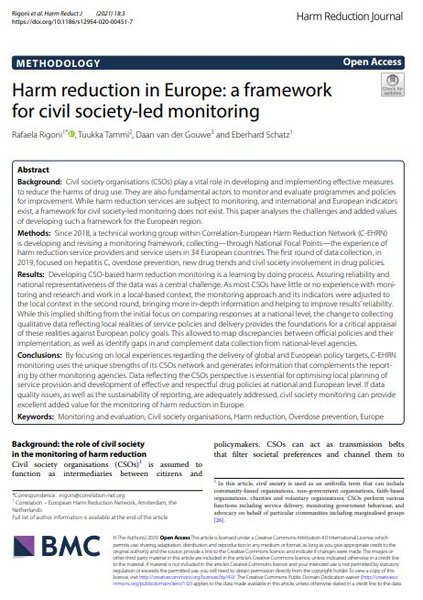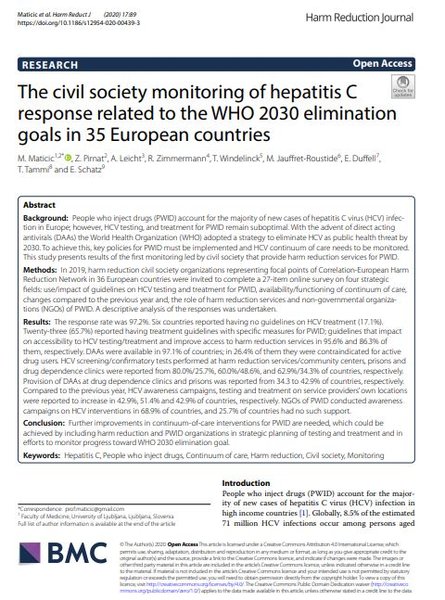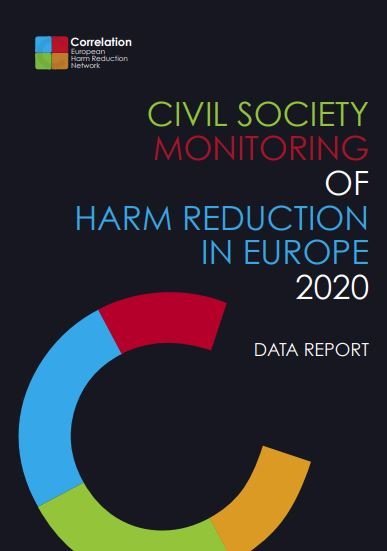Civil Society
Civil Society involvement in public health and harm reduction. Civil society can be understood as the "third sector" of society, distinct from government and business, and including the family and the private sphere.
Guidelines and Recommendations (Hungarian)
Guidelines and Recommendations for the Implementation of Minimum Quality Standards in Drug Demand Reduction in the European Union by Civil Society Organisations (CSO's)
Harm reduction in Europe: a framework for civil society-led monitoring
Rafaella Rigoni , Tuukka Tammi , Daan van der Gouwe , Eberhard Schatz
Background: Civil society organisations (CSOs) play a vital role in developing and implementing efective measures to reduce the harms of drug use. They are also fundamental actors to monitor and evaluate programmes and policies for improvement. While harm reduction services are subject to monitoring, and international and European indicators exist, a framework for civil society-led monitoring does not exist. This paper analyses the challenges and added values of developing such a framework for the European region.
Methods: Since 2018, a technical working group within Correlation-European Harm Reduction Network (C-EHRN) is developing and revising a monitoring framework, collecting—through National Focal Points—the experience of harm reduction service providers and service users in 34 European countries. The frst round of data collection, in 2019, focused on hepatitis C, overdose prevention, new drug trends and civil society involvement in drug policies. Results: Developing CSO-based harm reduction monitoring is a learning by doing process. Assuring reliability and national representativeness of the data was a central challenge. As most CSOs have little or no experience with monitoring and research and work in a local-based context, the monitoring approach and its indicators were adjusted to the local context in the second round, bringing more in-depth information and helping to improve results’ reliability. While this implied shifting from the initial focus on comparing responses at a national level, the change to collecting qualitative data refecting local realities of service policies and delivery provides the foundations for a critical appraisal of these realities against European policy goals. This allowed to map discrepancies between ofcial policies and their implementation, as well as identify gaps in and complement data collection from national-level agencies.
Conclusions: By focusing on local experiences regarding the delivery of global and European policy targets, C-EHRN monitoring uses the unique strengths of its CSOs network and generates information that complements the reporting by other monitoring agencies. Data refecting the CSOs perspective is essential for optimising local planning of service provision and development of efective and respectful drug policies at national and European level. If data quality issues, as well as the sustainability of reporting, are adequately addressed, civil society monitoring can provide excellent added value for the monitoring of harm reduction in Europe.
Keywords: Monitoring and evaluation, Civil society organisations, Harm reduction, Overdose prevention, Europe
The civil society monitoring of hepatitis C response related to the WHO 2030 elimination goals in 35 European countries
M. Maticic , Z. Pirnat , A. Leicht , R. Zimmermann , T. Windelinck , M. Jauffret-Roustide , E. Duffell , T. Tammi , E. Schatz
Background: People who inject drugs (PWID) account for the majority of new cases of hepatitis C virus (HCV) infec‑ tion in Europe; however, HCV testing, and treatment for PWID remain suboptimal. With the advent of direct acting antivirals (DAAs) the World Health Organization (WHO) adopted a strategy to eliminate HCV as public health threat by 2030. To achieve this, key policies for PWID must be implemented and HCV continuum of care needs to be monitored. This study presents results of the frst monitoring led by civil society that provide harm reduction services for PWID.
Methods: In 2019, harm reduction civil society organizations representing focal points of Correlation-European Harm Reduction Network in 36 European countries were invited to complete a 27-item online survey on four strategic felds: use/impact of guidelines on HCV testing and treatment for PWID, availability/functioning of continuum of care, changes compared to the previous year and, the role of harm reduction services and non-governmental organiza‑ tions (NGOs) of PWID. A descriptive analysis of the responses was undertaken.
Results: The response rate was 97.2%. Six countries reported having no guidelines on HCV treatment (17.1%). Twenty-three (65.7%) reported having treatment guidelines with specifc measures for PWID; guidelines that impact on accessibility to HCV testing/treatment and improve access to harm reduction services in 95.6% and 86.3% of them, respectively. DAAs were available in 97.1% of countries; in 26.4% of them they were contraindicated for active drug users. HCV screening/confrmatory tests performed at harm reduction services/community centers, prisons and drug dependence clinics were reported from 80.0%/25.7%, 60.0%/48.6%, and 62.9%/34.3% of countries, respectively. Provision of DAAs at drug dependence clinics and prisons was reported from 34.3 to 42.9% of countries, respectively. Compared to the previous year, HCV awareness campaigns, testing and treatment on service providers’ own locations were reported to increase in 42.9%, 51.4% and 42.9% of countries, respectively. NGOs of PWID conducted awareness campaigns on HCV interventions in 68.9% of countries, and 25.7% of countries had no such support.
Conclusion: Further improvements in continuum-of-care interventions for PWID are needed, which could be achieved by including harm reduction and PWID organizations in strategic planning of testing and treatment and in eforts to monitor progress toward WHO 2030 elimination goal.
Keywords: Hepatitis C, People who inject drugs, Continuum of care, Harm reduction, Civil society, Monitoring
CIVIL SOCIETY MONITORING OF HARM REDUCTION IN EUROPE 2020
Rafaela Rigoni , Tuukka Tammi , Daan van der Gouwe , Victoria Oberzil , Robert Csak , Eberhard Schatz
Please note: there are various version of this report if you click on the file!
This is the second civil society-led monitoring report produced by Correlation – European Harm Reduction Network (C-EHRN). The purpose of this report is to enrich the information and knowledge base of harm reduction interventions in Europe from the viewpoint of civil society organisations. The Monitoring report gathers data on the experiences of harm reduction service providers and service users at ground level, building on a network of national Focal Points (FPs) in Europe. For the 2020 monitoring, C-EHRN includes 35 FPs in 34 countries. To get insight at the implementation level, and to profit from the experiences and expertise of FPs, the 2020 monitoring focuses mostly on cities rather than countries. The main areas monitored are: essential harm reduction services, overdose prevention, Hepatitis C, New drug Trends, Civil Society Involvement and COVID-19 impact on harm reduction services and people who use drugs.





